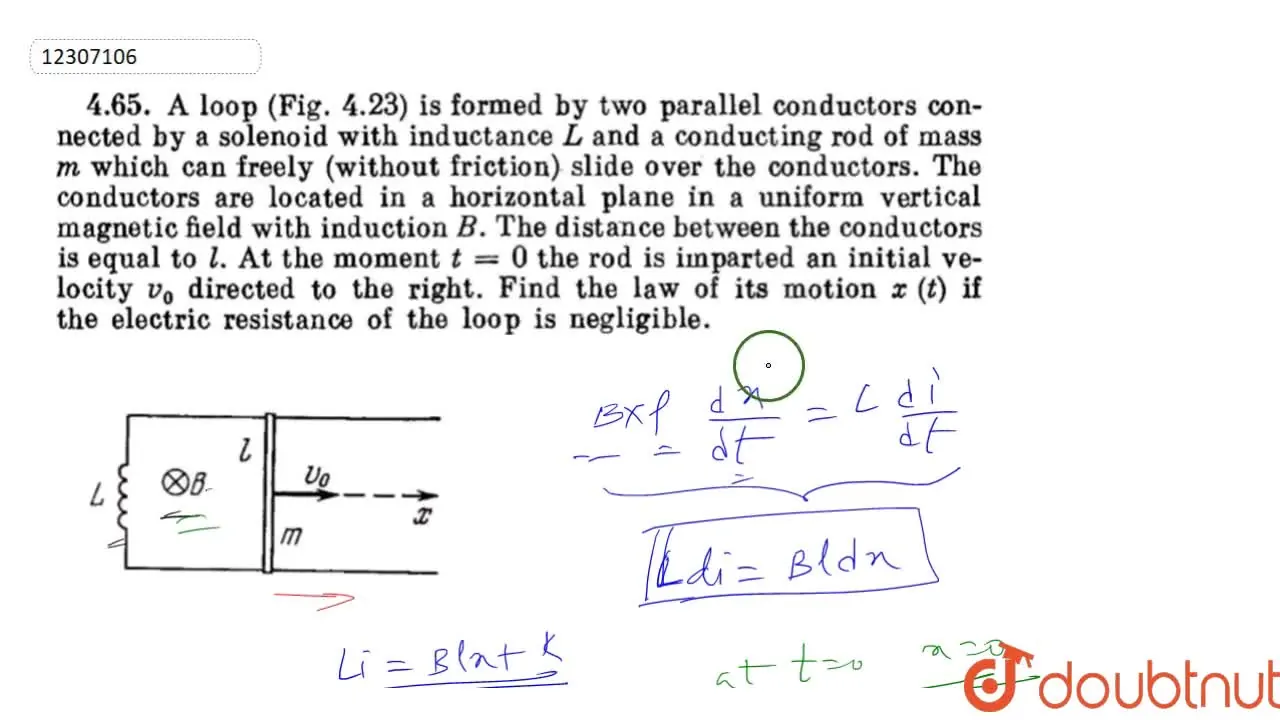A loop (figure) is formed by two parallel conductores connected by a solenoid with inductance L and a conducting rod of mass m which can freely ( without friction) slide over the conductors. The conductors are located in a horizontal plane in a uniform vertical magnetic field with induction B. The distance between the conductors is equal to l. At the moment t=0 the rod is imparted an initial velocity υ0 directed to the right. Find the law of its motion x(t) if the electric resistance of the loop is negligible.

We have in the circute at a certain instant of time (T), from Faraday's law of electromagentice induction :
Ldidt=Bldxdt or Ldi=Bldx
As at t=0,x=0 so Li=Blx or i=BlLx(1)
For the rod from the second law of motion Fx=mwx
−ilB=m..x
Using Eqn. (1), we get : ..x=−(l2B2mL)x=−ω20x....(2)
where ω0lB/√mL
The solution of the above differential equation is of the form
x=asin(ωt+α)
From the initial condition, at t=0,x=0, so α=0
Hence, x=asinω0t....(3)
Differentialting w.r.t. time, .x=aω0cosω0t
But from the initial condition of the problem at t=0,.x=v0
Thus v0=aω0 or a=v0/ω0...(4)
Putting the valur of a from Eqn (4) into Eqn. (3), we obtained
x=v0ω0sinω0t( whereω0=lB√mL)
Related Playlists
- BOOK - IE IRODOV, LA SENA & SS KROTOVCHAPTER - OSCILLATIONS AND WAVESEXERCISE - Electric Oscillations56videos
OSCILLATIONS AND WAVES
- BOOK - IE IRODOV, LA SENA & SS KROTOVCHAPTER - OSCILLATIONS AND WAVESEXERCISE - Elastic Waves39videos
OSCILLATIONS AND WAVES
- BOOK - IE IRODOV, LA SENA & SS KROTOVCHAPTER - OPTICSEXERCISE - Exercise2videos
OPTICS
- BOOK - IE IRODOV, LA SENA & SS KROTOVCHAPTER - PHYSICAL FUNDAMENTALS OF MECHANICSEXERCISE - Relativistic Mechanics49videos
PHYSICAL FUNDAMENTALS OF MECHANICS
Similar Questions
A loop is formed by two parallel conductors connected by a solenoid with inductance L and a conducting rod of mass m which can freely (without friction) slide over the conductors. The conductors are located in a horizontal plane in a uniform vertical magnet field B . the distance between the conductors is l . At the moment t=0 , the rod is imparted an initial velocity v0 directed to the right. Find the law of its motion x(t) if the electric resistance of the loop is negligible.
 View Solution
View SolutionA loop is formed by two parallel conductors connected by a selenoid with inductance L and a condutcing rod of mass which can freely (without friction) slide over the conductors. The conductors are located i a horizontal plane in as uniform vertical magnetic field B.The distance between the conductors is l.

At the moment t=0 the rod is impaert dan initial velocity v0 directed to the right. find the law of its motion d(t) if the electric resistance of the loop is negligibleView SolutionA loop is formed by two parallel conductors connected by a solenoid with inductance L=2H and a conducting rod of mass m=80g, which can freely (without fricition) slide over the conductors. The conductors are located in a horizontal plane in a uniform vertical magnetic field with induction B=4T.
The distance between the conductors is equal to l=4cm. At the moment t=0 the rod is imparted an initial velocity v0=2cm/s directed to the right. Find the amplitude (in cm) for the oscillations of conducting rod, if the electric resistance of the loop is negligible.
 View Solution
View SolutionA loop is formed by two parallel conductors connected by a solenoid with inductance L and a conducting rod of mass M which can freely slide over the conductors. The conductors are located in a uniform magnetic field with induction B perpendicular to the plane of loop. The distance between conductors is l. At t = 0, the rod is given a velocity v0 directed toward right and the current through the inductor is initially zero (below figure) .
 View Solution
View SolutionA conductor PQ , with PQ=r , moves with a velocity v in a uniform magnetic field of induced B . The emf induced in the rod is
View SolutionA conductor of length l and mass m can slide without any friction along the two vertical conductors connected at the top through a capacitor. A uniform magnetic field B is set up ⊥ to the plane of paper. The acceleration of the conductor
 View Solution
View SolutionThe self-inductance of a straight conductor is
View SolutionA current-carrying conductor placed in a uniform magnetic field experiences maximum force when the conductor is placed parallel to the magnetic field.
View SolutionA straight conductor of length L and carrying a current I is kept in a uniform magnetic field of induction →B. Write the expressions for the force on the conductor and the magnitude of the maximum force.
View SolutionA coducting rod of mass m=0.3kg and length l=4m can slide without friction on two parallel conducting rails. The conducting rails are connected via an inductancce L=3Mh. This system is placed in a region containing uniform magnetic field B=1T pointing into the plane. if the rod is given an initial velocity v0=2m/s, it oscillates with an amplituude Acm. Find the value of 2A
 View Solution
View Solution


